KIA Sportage 2013 SL / 3.G Owner's Guide
Manufacturer: KIA, Model Year: 2013, Model line: Sportage, Model: KIA Sportage 2013 SL / 3.GPages: 387, PDF Size: 8.44 MB
Page 21 of 387
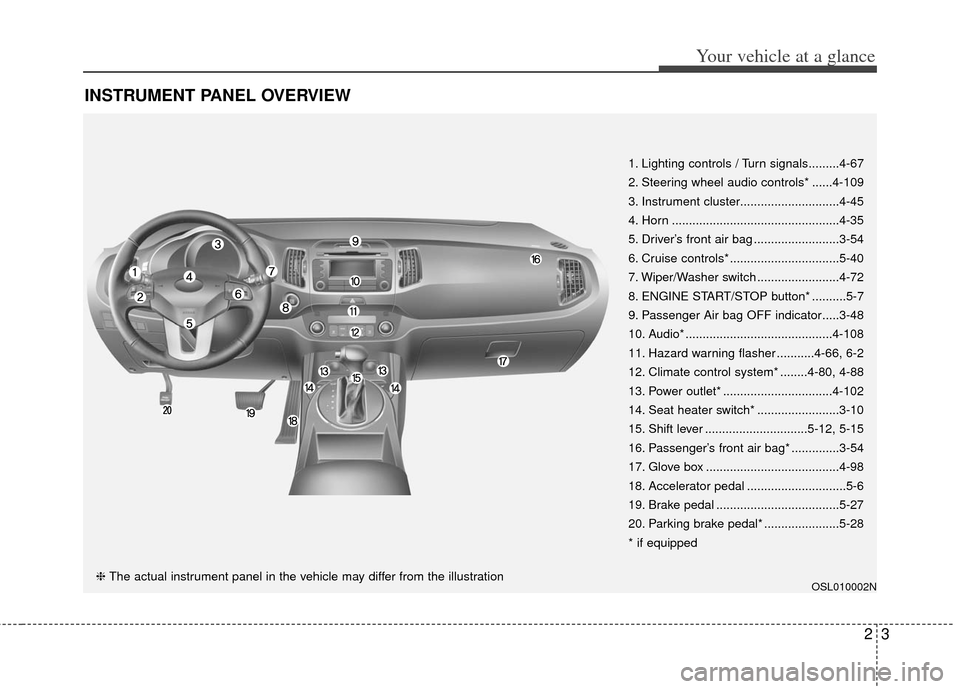
23
Your vehicle at a glance
INSTRUMENT PANEL OVERVIEW
OSL010002N
1. Lighting controls / Turn signals.........4-67
2. Steering wheel audio controls* ......4-109
3. Instrument cluster.............................4-45
4. Horn .................................................4-35
5. Driver’s front air bag .........................3-54
6. Cruise controls* ................................5-40
7. Wiper/Washer switch ........................4-72
8. ENGINE START/STOP button* ..........5-7
9. Passenger Air bag OFF indicator.....3-48
10. Audio* ...........................................4-108
11. Hazard warning flasher ...........4-66, 6-2
12. Climate control system* ........4-80, 4-88
13. Power outlet* ................................4-102
14. Seat heater switch* ........................3-10
15. Shift lever ..............................5-12, 5-15
16. Passenger’s front air bag* ..............3-54
17. Glove box .......................................4-98
18. Accelerator pedal .............................5-6
19. Brake pedal ....................................5-27
20. Parking brake pedal* ......................5-28
* if equipped
❈ The actual instrument panel in the vehicle may differ from the illustration
Page 22 of 387
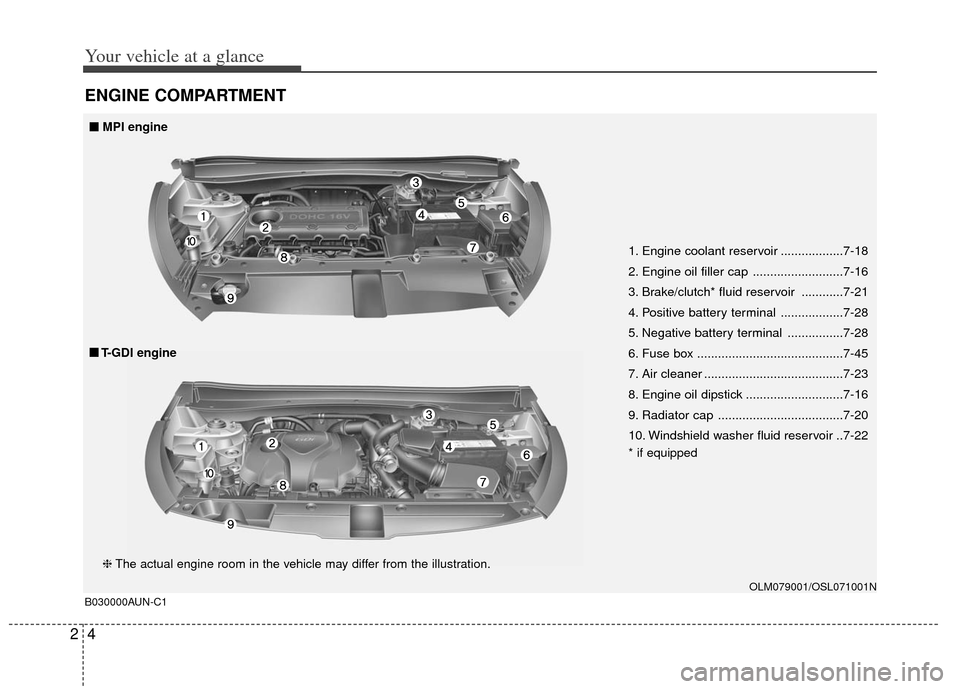
Your vehicle at a glance
42
ENGINE COMPARTMENT
B030000AUN-C1
1. Engine coolant reservoir ..................7-18
2. Engine oil filler cap ..........................7-16
3. Brake/clutch* fluid reservoir ............7-21
4. Positive battery terminal ..................7-28
5. Negative battery terminal ................7-28
6. Fuse box ..........................................7-45
7. Air cleaner ........................................7-23
8. Engine oil dipstick ............................7-16
9. Radiator cap ....................................7-20
10. Windshield washer fluid reservoir ..7-22
* if equipped
OLM079001/OSL071001N
❈The actual engine room in the vehicle may differ from the illustration.
■
■
MPI engine
■
■ T-GDI engine
Page 23 of 387

3
Seats / 3-2
Seat belts / 3-18
Child restraint system / 3-33
Air bag - advanced supplemental restraint system / 3-42
Safety features of your vehicle
Page 24 of 387
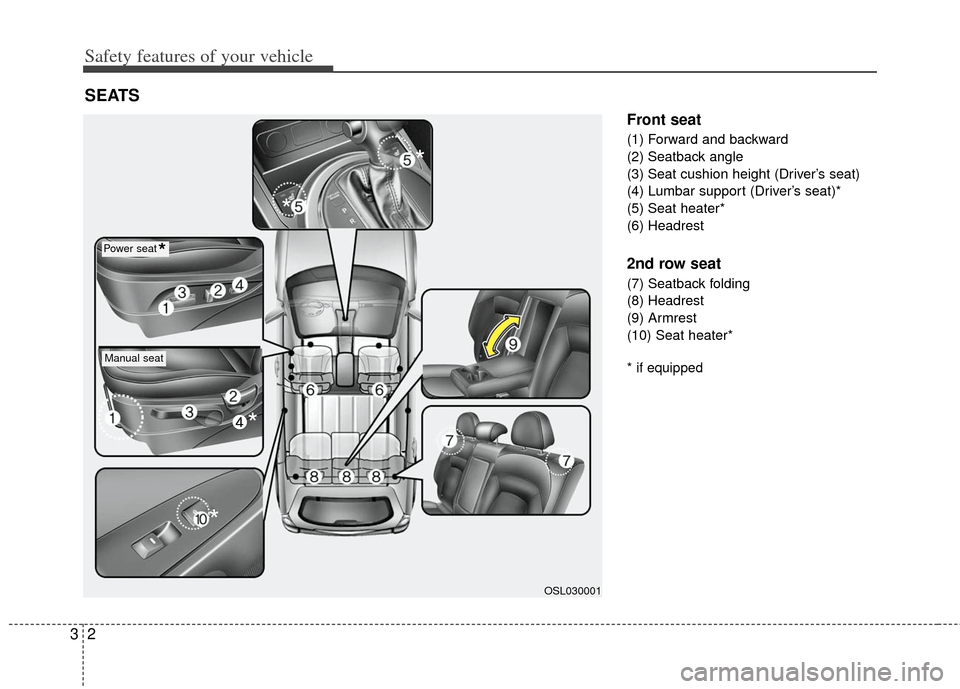
Safety features of your vehicle
23
Front seat
(1) Forward and backward
(2) Seatback angle
(3) Seat cushion height (Driver’s seat)
(4) Lumbar support (Driver’s seat)*
(5) Seat heater*
(6) Headrest
2nd row seat
(7) Seatback folding
(8) Headrest
(9) Armrest
(10) Seat heater*
* if equipped
SEATS
OSL030001
Manual seat
Power seat
*
* *
*
*
Page 25 of 387
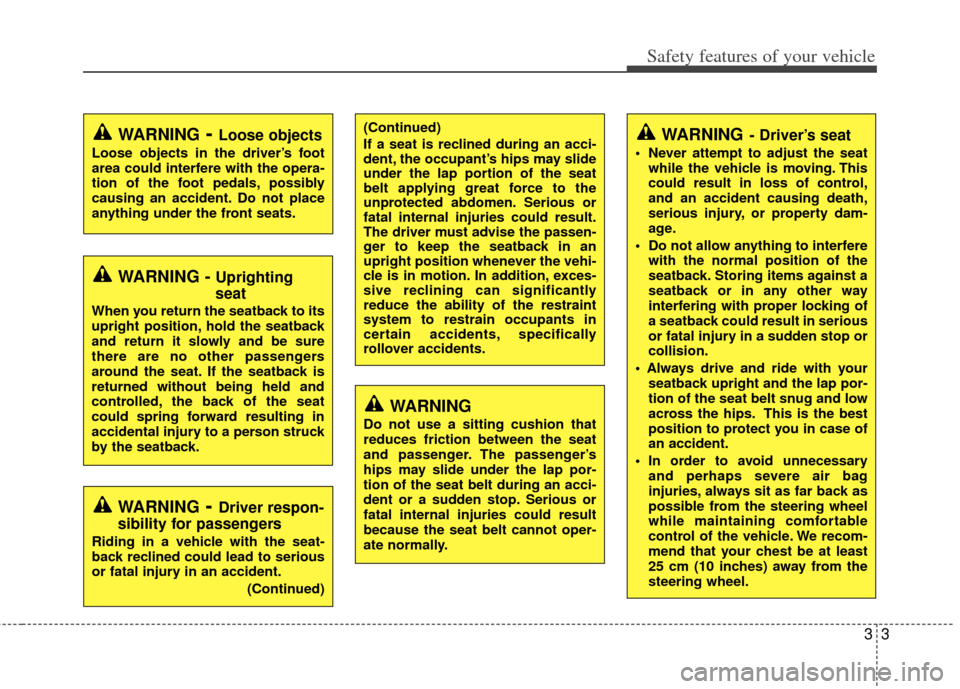
33
Safety features of your vehicle
WARNING- Driver’s seat
Never attempt to adjust the seatwhile the vehicle is moving. This
could result in loss of control,
and an accident causing death,
serious injury, or property dam-
age.
Do not allow anything to interfere with the normal position of the
seatback. Storing items against a
seatback or in any other way
interfering with proper locking of
a seatback could result in serious
or fatal injury in a sudden stop or
collision.
seatback upright and the lap por-
tion of the seat belt snug and low
across the hips. This is the best
position to protect you in case of
an accident.
In order to avoid unnecessary and perhaps severe air bag
injuries, always sit as far back as
possible from the steering wheel
while maintaining comfortable
control of the vehicle. We recom-
mend that your chest be at least
25 cm (10 inches) away from the
steering wheel.
WARNING - Uprighting
seat
When you return the seatback to its
upright position, hold the seatback
and return it slowly and be sure
there are no other passengers
around the seat. If the seatback is
returned without being held and
controlled, the back of the seat
could spring forward resulting in
accidental injury to a person struck
by the seatback.
WARNING- Loose objects
Loose objects in the driver’s foot
area could interfere with the opera-
tion of the foot pedals, possibly
causing an accident. Do not place
anything under the front seats.
WARNING
Do not use a sitting cushion that
reduces friction between the seat
and passenger. The passenger’s
hips may slide under the lap por-
tion of the seat belt during an acci-
dent or a sudden stop. Serious or
fatal internal injuries could result
because the seat belt cannot oper-
ate normally.
(Continued)
If a seat is reclined during an acci-
dent, the occupant’s hips may slide
under the lap portion of the seat
belt applying great force to the
unprotected abdomen. Serious or
fatal internal injuries could result.
The driver must advise the passen-
ger to keep the seatback in an
upright position whenever the vehi-
cle is in motion. In addition, exces-
sive reclining can significantly
reduce the ability of the restraint
system to restrain occupants in
certain accidents, specifically
rollover accidents.
WARNING- Driver respon-
sibility for passengers
Riding in a vehicle with the seat-
back reclined could lead to serious
or fatal injury in an accident.
(Continued)
Page 26 of 387
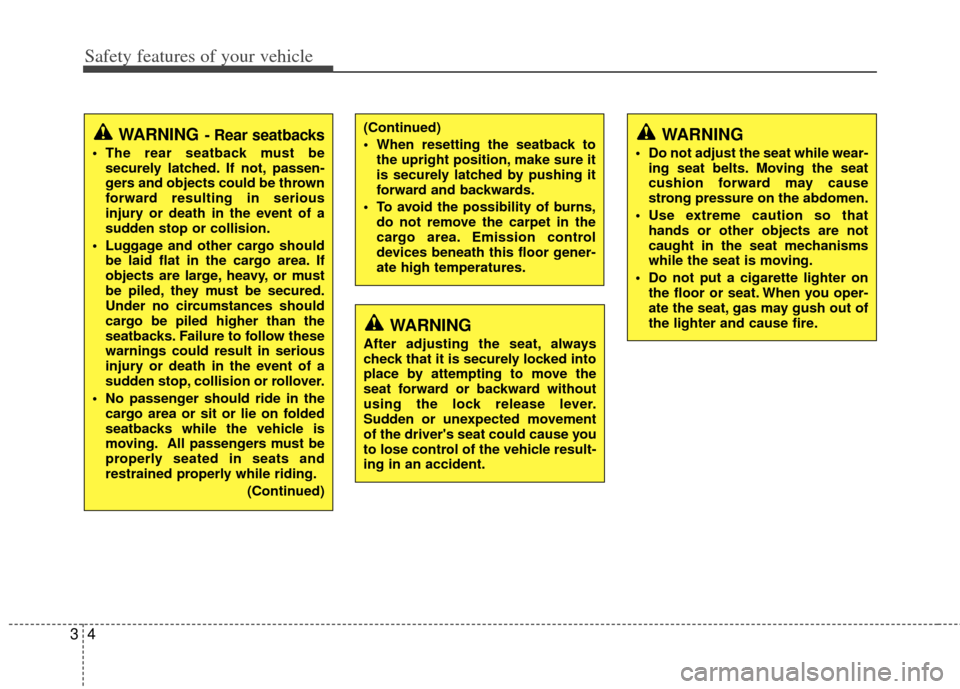
Safety features of your vehicle
43
(Continued)
When resetting the seatback tothe upright position, make sure it
is securely latched by pushing it
forward and backwards.
To avoid the possibility of burns, do not remove the carpet in the
cargo area. Emission control
devices beneath this floor gener-
ate high temperatures.WARNING- Rear seatbacks
The rear seatback must besecurely latched. If not, passen-
gers and objects could be thrown
forward resulting in serious
injury or death in the event of a
sudden stop or collision.
Luggage and other cargo should be laid flat in the cargo area. If
objects are large, heavy, or must
be piled, they must be secured.
Under no circumstances should
cargo be piled higher than the
seatbacks. Failure to follow these
warnings could result in serious
injury or death in the event of a
sudden stop, collision or rollover.
No passenger should ride in the cargo area or sit or lie on folded
seatbacks while the vehicle is
moving. All passengers must be
properly seated in seats and
restrained properly while riding.
(Continued)
WARNING
After adjusting the seat, always
check that it is securely locked into
place by attempting to move the
seat forward or backward without
using the lock release lever.
Sudden or unexpected movement
of the driver's seat could cause you
to lose control of the vehicle result-
ing in an accident.
WARNING
Do not adjust the seat while wear-ing seat belts. Moving the seat
cushion forward may cause
strong pressure on the abdomen.
Use extreme caution so that hands or other objects are not
caught in the seat mechanisms
while the seat is moving.
Do not put a cigarette lighter on the floor or seat. When you oper-
ate the seat, gas may gush out of
the lighter and cause fire.
Page 27 of 387
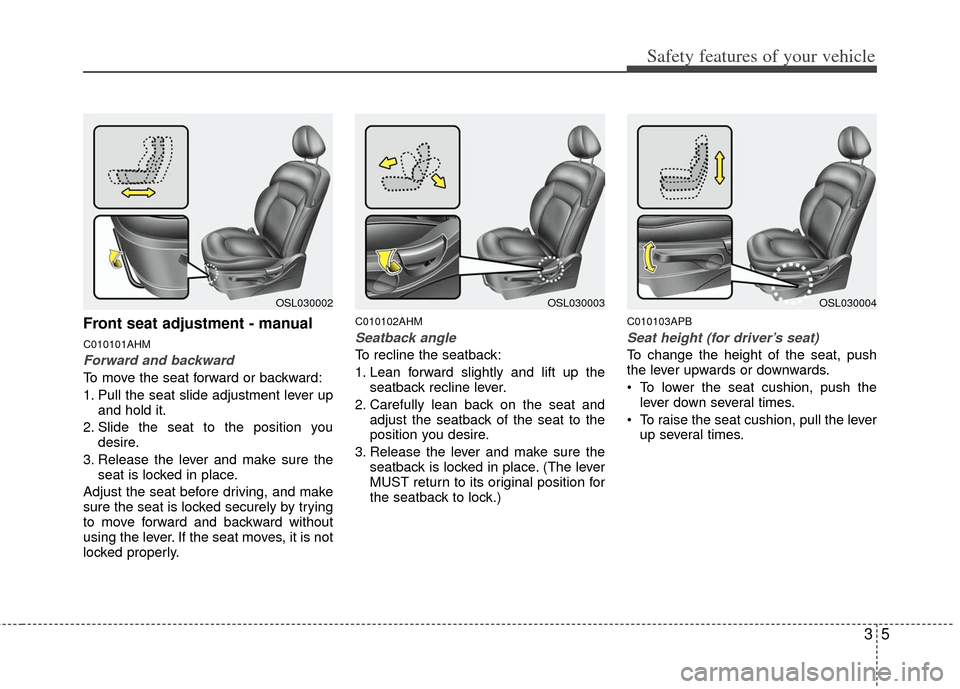
35
Safety features of your vehicle
Front seat adjustment - manual
C010101AHM
Forward and backward
To move the seat forward or backward:
1. Pull the seat slide adjustment lever upand hold it.
2. Slide the seat to the position you desire.
3. Release the lever and make sure the seat is locked in place.
Adjust the seat before driving, and make
sure the seat is locked securely by trying
to move forward and backward without
using the lever. If the seat moves, it is not
locked properly.
C010102AHM
Seatback angle
To recline the seatback:
1. Lean forward slightly and lift up the seatback recline lever.
2. Carefully lean back on the seat and adjust the seatback of the seat to the
position you desire.
3. Release the lever and make sure the seatback is locked in place. (The lever
MUST return to its original position for
the seatback to lock.)
C010103APB
Seat height (for driver’s seat)
To change the height of the seat, push
the lever upwards or downwards.
To lower the seat cushion, push thelever down several times.
To raise the seat cushion, pull the lever up several times.
OSL030002OSL030004OSL030003
Page 28 of 387

Safety features of your vehicle
63
Front seat adjustment - power
(if equipped)
The front seat can be adjusted by using
the control switches located on the out-
side of the seat cushion. Before driving,
adjust the seat to the proper position so
you can easily control the steering wheel,
pedals and switches on the instrument
panel.
Forward and backward
Push the control switch forward or back-
ward to move the seat to the desired
position. Release the switch once the
seat reaches the desired position.
CAUTION
The power seat is driven by anelectric motor. Stop operatingonce the adjustment is complet-ed. Excessive operation maydamage the electrical equipment.
When in operation, the power seat consumes a large amount ofelectrical power. To preventunnecessary charging systemdrain, don’t adjust the power seatlonger than necessary while theengine is not running.
Do not operate two or more power seat control switches at the sametime. Doing so may result inpower seat motor or electricalcomponent malfunction.
OSL030006WARNING
The power seat is operable with the
ignition OFF.
Therefore, children should never be
left unattended in the vehicle.
Page 29 of 387

37
Safety features of your vehicle
Seatback angle
Push the control switch forward or back-
ward to move the seatback to the desired
angle. Release the switch once the seat
reaches the desired position.
Seat height (for driver’s seat)
Pull the rear portion of the control switch
up to raise or press down to lower the
seat cushion. Release the switch once
the seat reaches the desired position.
Lumbar support (for driver’s seat)
The lumbar support can be adjusted by
pressing the button.
OSL030007OSL030008
OSL030063E
OSL030009
Type A
Type B
Page 30 of 387
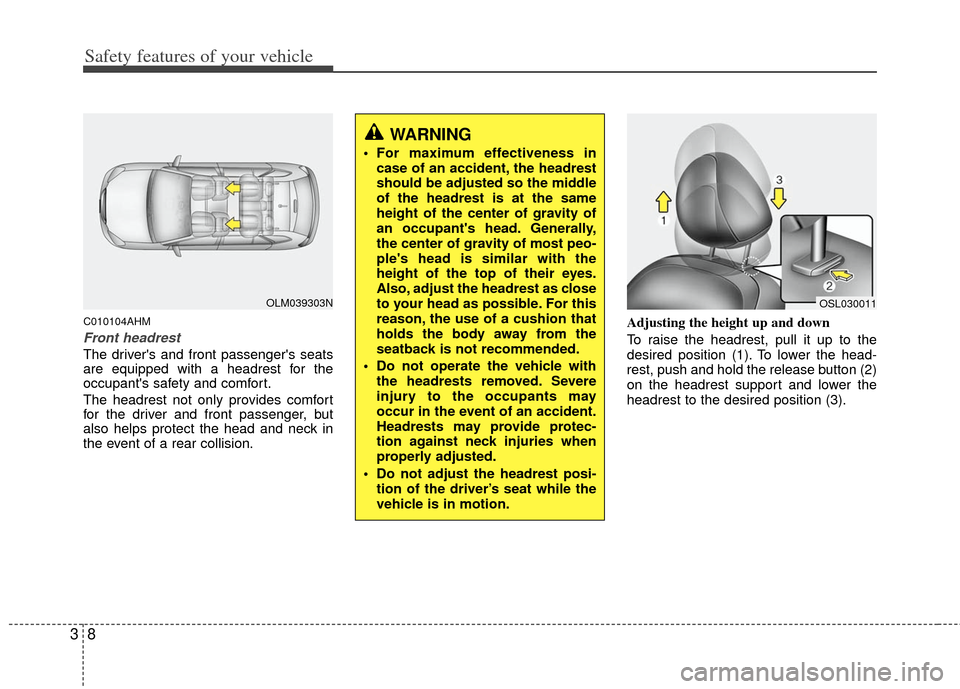
Safety features of your vehicle
83
C010104AHM
Front headrest
The driver's and front passenger's seats
are equipped with a headrest for the
occupant's safety and comfort.
The headrest not only provides comfort
for the driver and front passenger, but
also helps protect the head and neck in
the event of a rear collision.Adjusting the height up and down
To raise the headrest, pull it up to the
desired position (1). To lower the head-
rest, push and hold the release button (2)
on the headrest support and lower the
headrest to the desired position (3).
WARNING
For maximum effectiveness in
case of an accident, the headrest
should be adjusted so the middle
of the headrest is at the same
height of the center of gravity of
an occupant's head. Generally,
the center of gravity of most peo-
ple's head is similar with the
height of the top of their eyes.
Also, adjust the headrest as close
to your head as possible. For this
reason, the use of a cushion that
holds the body away from the
seatback is not recommended.
Do not operate the vehicle with the headrests removed. Severe
injury to the occupants may
occur in the event of an accident.
Headrests may provide protec-
tion against neck injuries when
properly adjusted.
Do not adjust the headrest posi- tion of the driver’s seat while the
vehicle is in motion.
OSL030011OLM039303N